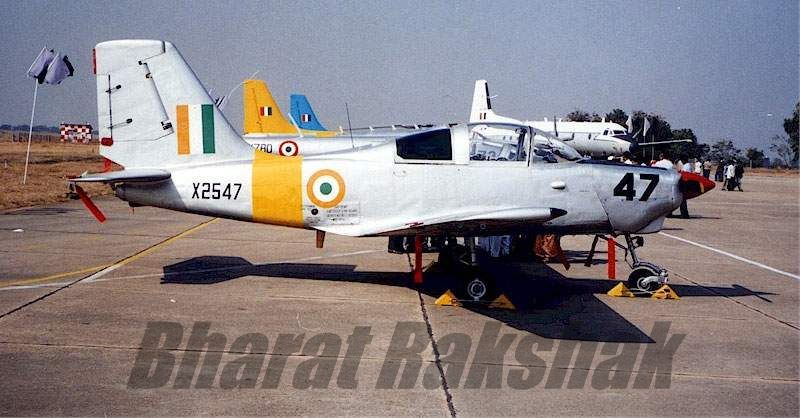
Origin: India.
Type: Two-seat, basic propeller-driven trainer.
Accommodation: Seating for two side-by-side and provision for a third seat behind.
Weights: Basic Empty – 890 kg (1962 lbs)
………….Max. Takeoff – 1250 kg (2756 lbs)
Engine: One 195kW (260hp) Textron Lycoming EIO-540-D4B5 flat six piston engine driving a two-blade constant speed propeller.
Performance: Max. speed at sea level 265 km/h (143 knots)
………………Economical cruising speed 176 km/h (95 knots)
………………Max cruising speed 213 km/h (115 knots)
Max. Initial Rate of Climb: 1100 ft/min.
Service Ceiling: 18,045 feet.
Range: At 10,000 feet with economical cruising power – 745 km (400n miles)
Avionics: None.
Armament: None.
Self Defence: None.
Comments: India’s indigenous HAL HPT-32 Deepak is used for initial pilot training and other utility tasks. The Deepak was developed by HAL for the IAF to replace the tandem two-seat HT-2 basic trainer and to undertake a range of other utility roles like armed patrol, observation, liaison work, supply dropping, SAR, recon, glider, target towing, and even for weapon training and light strike.
The prototype first flew on 06 January 1977, followed by a second on March 1979. However, the early prototypes failed to meet the specific requirements of the IAF and thus the aircraft were re-designed with various aerodynamic changes and underwent a weight reduction program. The third prototype, built to the definitive production standard, flew in July 1981. Production deliveries did not start till 1984, with 12 aircraft handed over to IAF, which were based at the IAF’s Elementary School at Bidar.
The initial IAF requirement was for 160 HPT-32s, the first production batch of 24 was followed by successive re-orders which took deliveries to 120 delivered through early 1990s. A small number of aircraft were also transferred to the IN. The design is quiet conventional and features a semi-monocoque structure with stressed skin, fixed tricycle undercarriage, and a rear-ward sliding canopy above the two side-by-side seats. There is room for a third trainee in the back of the two seats. The aircraft is fully aerobatic.
The only development of the HPT-32 Deepak, was the turboprop powered HTT-34 which was developed as a private venture by HAL. The 313kW (420shp) Allison 250-B17D powered HTT-34 flew for the first time, in a converted HTP-32 prototype form, on 17 June 1984. A second pre-production prototype was also unveiled in 1989, other changes included a stretch of 35 cm and a smaller tail. The new engine significantly boosted performance on the the basic aircraft, but was cancelled as official interest was not forthcoming.
The aircraft had always been plagued by fuel line problems and there were dozens of incidents in which the engine cut in mid-flight forcing pilots to put down the aircraft in emergency landings.
After a fatal accident on the HPT-32 aircraft on July 31, 2009, a decision was taken by Air Headquarters to ground the HPT-32 aircraft fleet. The Indian Air Force (IAF) grounded its entire fleet of initial trainer HPT-32 aircraft.
All the aircraft had been withdrawn and have been stored at Air Force Academy Dundigal. They have since been replaced by the Pilatus PC-7 MkII for training.
A total number of 17 HPT-32 aircraft had crashed till date and 19 pilots had lost their lives in these accidents.
Accidents: http://www.bharat-rakshak.com/IAF/Database/Accidents/listing.php?qacid=69&qt=TY
|
The Indian Air Force grounded all of its HPT-32 Deepak Trainers being used for ab-initio training after a fatal accident in 2009. They have been now all stored at one location for the last six years, gathering dust and soaking up the sun…. |